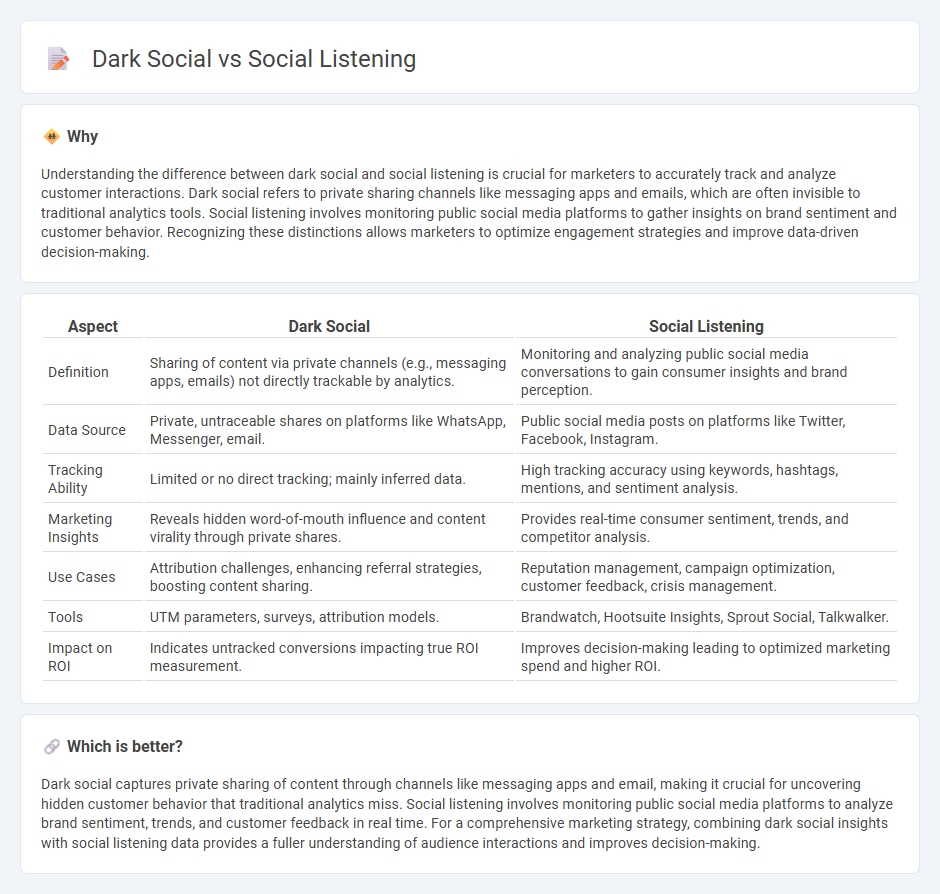
Dark social refers to the sharing of content through private channels such as messaging apps, email, and direct messaging, making it difficult for marketers to track engagement through traditional analytics. Social listening involves monitoring public social media conversations to gather insights on customer sentiment, brand perception, and emerging trends. Explore how integrating dark social analysis with social listening can enhance your marketing strategies and uncover hidden opportunities.
Why it is important
Understanding the difference between dark social and social listening is crucial for marketers to accurately track and analyze customer interactions. Dark social refers to private sharing channels like messaging apps and emails, which are often invisible to traditional analytics tools. Social listening involves monitoring public social media platforms to gather insights on brand sentiment and customer behavior. Recognizing these distinctions allows marketers to optimize engagement strategies and improve data-driven decision-making.
Comparison Table
| Aspect | Dark Social | Social Listening |
|---|---|---|
| Definition | Sharing of content via private channels (e.g., messaging apps, emails) not directly trackable by analytics. | Monitoring and analyzing public social media conversations to gain consumer insights and brand perception. |
| Data Source | Private, untraceable shares on platforms like WhatsApp, Messenger, email. | Public social media posts on platforms like Twitter, Facebook, Instagram. |
| Tracking Ability | Limited or no direct tracking; mainly inferred data. | High tracking accuracy using keywords, hashtags, mentions, and sentiment analysis. |
| Marketing Insights | Reveals hidden word-of-mouth influence and content virality through private shares. | Provides real-time consumer sentiment, trends, and competitor analysis. |
| Use Cases | Attribution challenges, enhancing referral strategies, boosting content sharing. | Reputation management, campaign optimization, customer feedback, crisis management. |
| Tools | UTM parameters, surveys, attribution models. | Brandwatch, Hootsuite Insights, Sprout Social, Talkwalker. |
| Impact on ROI | Indicates untracked conversions impacting true ROI measurement. | Improves decision-making leading to optimized marketing spend and higher ROI. |
Which is better?
Dark social captures private sharing of content through channels like messaging apps and email, making it crucial for uncovering hidden customer behavior that traditional analytics miss. Social listening involves monitoring public social media platforms to analyze brand sentiment, trends, and customer feedback in real time. For a comprehensive marketing strategy, combining dark social insights with social listening data provides a fuller understanding of audience interactions and improves decision-making.
Connection
Dark social channels, such as private messaging apps and email, generate significant untracked traffic that traditional analytics tools often miss, complicating marketing attribution. Social listening tools monitor conversations across social media platforms, uncovering insights from both public and some dark social interactions by analyzing shared content and user sentiment. Combining dark social data with social listening enables marketers to gain a comprehensive understanding of customer behavior, optimize campaigns, and enhance engagement strategies.
Key Terms
Social Listening: sentiment analysis, brand monitoring, audience insights
Social listening involves analyzing online conversations to extract sentiment analysis, track brand mentions, and gain valuable audience insights, enabling businesses to understand public perception and customer needs in real-time. It leverages AI-driven tools to monitor social media platforms, blogs, and forums, offering a comprehensive view of brand health and emerging trends. Explore more to harness social listening for strategic marketing and enhanced customer engagement.
Dark Social: private sharing, attribution challenge, invisible traffic
Dark social involves the private sharing of content through channels like messaging apps, email, and encrypted platforms, making the origin of traffic difficult to attribute accurately. This invisible traffic bypasses traditional analytics tools, creating challenges for marketers attempting to track user engagement and ROI effectively. Explore strategies to unlock insights from dark social and enhance your digital marketing efforts.
Social Listening:
Social listening involves monitoring online conversations and social media platforms to gather insights about brand perception, customer sentiment, and trending topics, utilizing tools like Brandwatch and Hootsuite Insights. It enables businesses to respond promptly to feedback, identify potential crises, and optimize marketing strategies based on real-time data from platforms such as Twitter, Facebook, and Instagram. Discover how social listening can transform your brand's engagement and reputation management efforts.
Source and External Links
Social Listening Explained: How to Understand Your Audience - Social listening is a strategy that helps brands sift through vast social data to understand consumer opinions in real-time, enabling faster and broader market insights compared to traditional focus groups, with less budget and human resources needed.
Social listening - Medallia - Social listening involves monitoring social media, websites, blogs, and forums to analyze brand perception, sentiment, and to improve product development and marketing campaigns by responding directly to customer feedback.
Social listening in 2025: How to turn insights into business value - Social listening tracks conversations around your brand and industry to help you stay on-trend, improve customer experience, guide product development, protect brand reputation, and demonstrate ROI through real-time, actionable insights for strategic decision-making.
 dowidth.com
dowidth.com